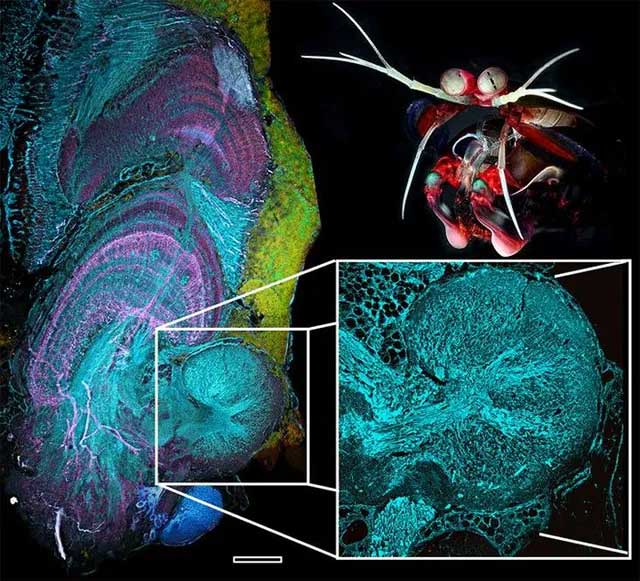Shrimp possess the most complex vision of any animal
Mantis shrimp are capable of seeing ultraviolet, infrared and polarized light. This species is considered to be the most complex vision possessor of all animals known on Earth.
How a finger-sized arthropod processes so many image details with such a small brain is a mystery that has not yet been solved with scientists.
Using many of the most advanced microscope techniques, researchers from Sweden, the US and Australia analyzed a set of structures in the animal's nervous system to better understand how a tiny creature like mantis shrimp sense a complex amount of images. This creature is more closely related to crabs and lobsters, ranging in size from about 10cm to more than 30cm.

Mantis shrimp have eyes with the most special eyesight of animals.
Exactly why they have such superior visibility is unclear, possibly related to mate identification or even sharing secret messages that other species cannot receive.
In fact, we can only imagine what mantis shrimp see. Its compound eyes contain more than a dozen types of photoreceptors, some of which are ultraviolet. Moreover, they can also detect circularly polarized light thanks to specialized optical structures.
Given this particular ability, scientists are interested in how the relatively simple brains of mantis shrimp can translate information from such complex eyes. At the beginning, the team focused on a spot of kidney-shaped neurons located in each eye stalk.
Researchers have used staining techniques and classic microscopes to follow the path of the nerves that connect the body map in mantis shrimp to other brain parts, creating a functional map. power for their visual system.
In other invertebrates, the critical part of the brain takes the total amount of visual information processed by the other part and converts it into something meaningful, such as a well-defined shape. clear.
"This arrangement could allow mantis shrimp to store fairly high visual information," says neuroscientist Nicholas Strausfeld from the University of Arizona.
A few years ago, Strausfeld and his colleagues also showed that the reniform cell blocks in crabs serve as learning and memory centers. For mantis shrimp, that could mean a copy of the memory hub.
But how and when the relatives of the mantis shrimp group develop such specialized nerve units is now a big question. There is also much work to be done to understand the meaning of having such discrete memory units.
- Discovering new possibilities of mantis shrimp
- The vision of mantis shrimp reveals a new way of looking at animals
- The unusual eyes of animals (II)
- Intense vitality of living creatures at
- Eyes of mantis shrimp
- 'Strange' work of doctor shrimp
- Discovering new abilities of mantis shrimp
- Video: Scary weapon of hammerhead shrimp
- How interesting is the scene through the prism of animals
- The truth about shrimps is that many people think they know that they turned out to be wrong
- Killer shrimp 'annexed' African creatures
- Video: Sea shrimp skewered with belly, tearing the arowana in the blink of an eye
- The most monstrous 'killer' shrimp in the world
- Insects have the best vision in the animal world
 Surprised: Fish that live in the dark ocean still see colors
Surprised: Fish that live in the dark ocean still see colors Japan suddenly caught the creature that caused the earthquake in the legend
Japan suddenly caught the creature that caused the earthquake in the legend A series of gray whale carcasses washed ashore on California's coast
A series of gray whale carcasses washed ashore on California's coast Compare the size of shark species in the world
Compare the size of shark species in the world